
 Iman Abdullah Iman Abdullah
Munich, Germany
Ritual of Signs I
Mixed media on paper
80x60cm
'28932966102, in the silence of my sanctuary and solitude I pronounce holy purification of the heart, platforms and configurations 10432723921142214 26/22. It is the opposite entirety of absolute exposure 12821062192107 where soundless revelations in the depths of my being are denied. In the absence of consciousness, where human expression of an unspoken concept reveals both sides of the truth, I construct a shelter to retrieve my fortune 82/18136. The glass barrier within me shatters. Through the debris of mantra and silenced murmurs I hear an inner call hai ala al salat (rise to prayer). In confidence I proceed towards a secret tawaf (orbital ritual) and I whisper lebbaik Allahumma lebbaik (Allah, I am at your command). This then becomes a reflection of materialistic subjectivity 13107358765076447016566136611130. After a period of compulsory stillness, I enter in an erratic, spontaneous non-conscious conversation, which aims to measure spirituality. In this capricious way, not vacant of presence, lays my destination, my art and my freedom. I wander the streets and alleyways of the city, imbedded with times long gone, perceiving the effect of the universe and our mute relationship with our surroundings. I penetrate the pathways of my memory, where instant illumination of the moment occurs as 287, and the world is exposed as 181. Signs and symbols; are a presence of that which exists as truth. The icons of completion and opposites are what triumph, for there must be "light'' against "darkness'' and "existence" against "nothingness".' Iman Abdullah . 1997
 Sadik Kwaish Alfraji Sadik Kwaish Alfraji
Amersfoort, The Netherlands
Sorrow
Mixed media on wood
81 x 61cm
1999
'Saddened like a stooping palm tree, I have known, that ''truth'' is far greater than just an idea. I have understood that all ''intellect'' has brought about, since Socrates, is no more than nonsense, that offers no solace. It so happens that I exist...it so happens that I paint...and it so happens that painting is my ''talisman'', a magic that is my retreat...a mysticism that is my sustenance.' 'A kind of holiness in art renders the artist similar to a priest. This lends his accomplishment a super ability to survive and remain. It may serve a purpose or carry a message. Ultimately, ''art'' is a kind of ''frequency'', connecting the inside of a being with its outside. It embodies an endurance, which transcends history and the everlasting eagerness for knowledge. The dramatic change of art in history is but a signal to art's richness in that we are not able to encompass it in one single definition or ideology (including my own understanding). I say, ''art and existence'' knowing only too well that ultimately, some thread will continue to tie between the accomplishment from one side and the essence from another.' Sadik Alfraji . 1993, 2000
 Shoresh Amin Shoresh Amin
Nyköping, Sweden
Symbiosis
Bronze sculpture
59 x 36 x 5cm
1997
'I was born during a miserable and painful time of war and destruction in my native country. I have grown and evolved as a man as well as an artist during times of exile, in a new country where I found a home. From the very beginning of my artistic career, the message I wanted to convey was clear: to depict the consequences of power, oppression and exploitation, which have constituted the circumstances under which I have lived my life. In later years my view of the world has become more complex and I have gone to using simpler but at the same time universal forms of expression; a framework that encompasses all, from a child's first attempts to communicate to the most refined forms of art and architecture. Art is beautiful when describing the painful and the gruesome aspects of life, as well as the wonderful and miraculous ones. The beauty lies within the actual artistic expression and the forms through which the artist interprets the world. The ultimate task for the artist is to give his artwork its own existence, independent of the artist himself. I am not a writer for he who writes uses a pencil and words, while I use colour, lines and forms. However, what we both want to achieve through our creativity is to awaken the unconscious senses within. For both of us, the answer to the elementary question ''why do we exist?'' is that we live to create, and we live for all that which our art is about. Art is a language undergoing constant changes, at all times the artist must know what it is he creates and why he does it. Ultimately, art can speak for itself and live on without the artist himself.' Shoresh Amin . 2000
 Jananne al-Ani Jananne al-Ani
London, England
Untitled (Gulf War Series)
B/W photographs
Edition 2/5
20 units of 20 x 20cm each
1991
Collection the Imperial War Museum, London
'Untitled (Gulf War Series) was the first work I made after the official end of the Gulf War in which I attempted to bring together a number of issues raised during the conflict. Despite a long-term interest in Orientalism in Western painting and photography, the war brought me face to face in a more urgent and immediate way, with the issues at the heart of the differences between East and West. It was a revelation to find that the Orientalist stereotype of the Arab and the Desert had remained in the Western consciousness and was brought to the fore through the portrayal of the population, culture and landscape of the Middle East in the Western media. Little effort was made to place the conflict in an informed historic context. Few references were made to what was happening on the ground during the bombing campaign. The site of the war was represented as a place with no history, no population and no future. In choosing to work with appropriated photographic images I endeavoured to explore the complex history of the medium and its relationship to its subject. The photographs of archaeological artefacts from Ur are recorded through photography's apparently neutral and scientific eye. The family has been the focus of attention since the invention of photography but what does the humble family snapshot reveal about the particularity of time and place? Photography replaced painting as the medium of the formal portrait and has an immediacy and an indexical relationship with its subject which we identify as contemporary. Photography also claims this intimate relationship with reality in its guise as documentary and reportage. Val Williams writes of this work ''Conundrums exist, too, in Al-Ani's exploration of the collision between family life and the facts of war. She uses photography to juxtapose views of her Iraqi homeland (employing war reportage, historical document and the family album) to create a composite picture which offers no explanations and no easy solutions to the dysfunction which comes not from within the family, but from the ambitions of politicians and the turmoil of war''.'* Jananne al-Ani . 2000
*Who's Looking at the Family?, Barbican Art Gallery, London, 1994
 Sina Ata Sina Ata
Manama, Bahrain
The Final Letter
Oil on canvas
90x80cm
1996
'The Final Letter: A moment of truth, a realisation. The constants in life are very few, the name of God (on top of the square) is one of them. The square in the middle: the story, amidst an ocean of mystery; life. The sentiment my work goes beyond the actual objects, especially when they take on more of a human form, addressing the same issues of rejection and disappointment. Injustice has often been a major drive behind what I do, be it an unjust lover, politician or other. Having lived in Iraq for most of my life, these injustices become second nature, and as unfortunate as that is, it has given me an unlimited source of input. This was probably one of the reasons that made me turn to art back in the 1980s with the start of the Iraq-Iran war.' Sina Ata . 1999
 Hamid al-Attar Hamid al-Attar
Surrey, England
Gilgamesh
Mixed media on wood
180 x 100cm
1998
Collection of the artist
‘We are living wearing death’s shroud under the wing of alleged freedom. We appear free in a very big prison cell. Fear permeates us day and night and we are always at the mercy of the visitor of death - forgive me - the dawn visitor. And from the set-backs of this kind of life, my work was born. It is important not to deceive people with smoke screens, but to shock them face on in order to stir them into action, to make them revolt against their oppressive reality.’ Hamid al-Attar . 1998 . Hamid al-Attar’s artworks are very complex and offer many layers of meaning. Recent works continue his long-standing concern with humanitarian issues; haunting ‘‘death mask’’ compositions; corpse-like low relief figures; poisonous colours; demons evoked from distorted African masks; falling figures struck by some invisible, deadly force - all have a deep and upsetting impact on the viewer. One feels like hiding from such images, but even when turning away, the images haunt us in our mind. Indirectly, the artist points out in his works that there has been struggle from Gilgamesh to Shatila and beyond. The unsettled and often gruesome reality of his paintings perpetually recalls the existential combat of mankind. Never does he try to hide or falsify reality, never does he gloss over oppression and cruelty. Attar began his artistic search and experimentation by delving deep into the ancient history of his country and began to gain a deep understanding of his roots. Later, his work is characterised by a much more complex approach to humanity, with strange symbols and shapes representing self-portraits that in turn stand for the universal human being and his struggles. Indeed, his talent became a weapon in defence of human beings, fostered by a profound understanding of his nation and its history. At all times his style avoids borrowing from other artists and he meets with very few international artists with ideological tendencies.’ Ulrike al-Khamis . 1999
 Maysaloun Faraj Maysaloun Faraj
Salat (series I-IV)
Ceramics
Unglazed Earthstone
2002
Bism Allah al-Rahman al-Rahim
In anguish and despair…in anticipation of war on Iraq…in yearning for solace and peace, ‘Salat’ was born. Each artwork in the Salat series is a simple and uncomplicated structure which concentrates on the actual composition rather than its construction. I also chose not to apply any glaze, keeping the forms as pure and earthy as possible. Having said this however, they are meant to be exhibited in ‘twos’ as with most of my works - il wihdeh il Allah (Oneness is for God)! Amongst other reasons, this gives them a sturdier more complex appearance. I guess it is the architect in me! Then again, perhaps it is my infinite need to ‘connect’. The work was created following a period of intensely hand-built coiled forms. It was like a breather for me as I found them particularly peaceful, contemplative and fulfilling in comparison with other techniques I employ. The result in my view resembles shapes in worship, in prayer, in Salat. With growing concern, I observe the injustice and upheaval in my homeland…in our world…and I pray; not as a last resort, but as a profound means for the ultimate solution. The Arabic word Salat originates from the word ‘Silla’, meaning ‘link’ (in this instance; with The Creator). It is this link that is at the core of my artistic expression as it is the ‘weakening’ of this link that is at the core of all evil. I would like to see a designated International Prayer Day where people world-over could join together in a collective Salat, whatever their faith, however they choose to ‘connect’. Only then may healing begin…only then may peace have a chance. Until such time, I shall continue to create…I shall continue to ‘Ussalli’/connect, wa ma tawfeeqi illa billah (and my success is only through God). Maysaloun Faraj . June 2003
 Said Farhan Said Farhan
Lausanne, Switzerland
La Valise de Najib (Najib’s Suitcase)
Mixed media
47 x 32cm
2000
Collection of the artist
Carrying Exile Away
‘When Said Fahran left off to exile, all he took with him was a suitcase. It was anonymous, of course, and it contained just enough to survive as well as a few personal treasures: a fragment of the East, a testimony of the artist’s life and universe, of his sensitive landscape. They were symbols of a life rich in emotions, family ties, voices, places, colours, scents, signs and lights. As years went by, they became the beacons of a creative spirit that found its expression in the art and technique of painting. Haunted by his past, Farhan started gradually to metamorphose his exile and identity as a countryless person into a creative ode with no limits, language nor nationality. He finds inspiration in souvenirs of the past while at the same time drawing energy from the present, from the countries and towns where he lives, from the places he works in. In this way he began carefully to settle accounts with his personal experience. It was through the art of painting that he engaged into a dialogue that enabled him progressively to view his destiny as a wandering freedom. The light that emerges from his Iraqi roots has been seeping with increasing intensity into his work. He now feels ready to understand and appreciate why the real destiny of an émigré does not unfold in a specific country but by the authenticity and force of emotions, wherever they occur. This revelation and the rediscovery of the suitcase he had taken away from home many years ago inspired a new set of paintings. Their central and highly symbolic theme is the suitcase. These works are made of pieces of painted cloth, sewn together with string and surmounted by a simple wooden stick. Their material bears the scars of the painter’s exile. The artist understands and shows that it is only through art that the reality of everyday life, transcended by experience, can give sense to the fragility of emotions imprisoned by the mirages of time. This unforgettable human experience helps understand why the painter’s work will never be inspired by one place but by all places. Each sign refers to this universal freedom and openness. Exile - a book that one cannot finish writing - will always remain an inner image that can sometimes be grasped by a resurgent souvenir, an emotion, a colour, a scent or a voice. Let the painter pick up his suitcase, for it carries a secret hidden in an even deeper secret that only the act of creation can apprehend and express.’ Armande Reymond[1] . 2000
[1] Portrait of the Artist as a Suitcase, Visinand Museum, Montreux, May 2000
 Ghassan Ghaib Ghassan Ghaib
Baghdad, Iraq
Untitled
Oil on canvas
100 x 140cm
1998
Private collection
‘My artwork reflects my environment in abstract forms and my reality becomes abstracted in terms of existential essence, rather than identifiable in a comprehensible visual depiction. As a result of this approach my canvases stand as abstract modulations of colour and texture. Through these I attempt to express the passionate emotions locked up in my soul: sometimes they join in harmony and sometimes they clash in conflict with each other. In approaching my work, I apply every step deliberately and in a premeditated fashion. To me the media I use whether they be colour pastes, wood, ink, bronze, natural ingredients or human refuse like textile or newspaper scraps, are all imbued with profound significance in themselves. I work them and with them in a deliberate fashion, each step in the creative process of as much importance as the final artwork itself.’ Ghassan Ghaib . 1998
 Naman Hadi Naman Hadi
Paris, France
Le Déraciné Uprooted)
Oil on canvas
130 x 195cm
1984
Collection of the artist
‘The search for technical perfection characterises what has occupied me in my art during preceding periods. I am certain that technique is the basis for every work of art, and it is adequate technical skill that leads towards the process of creativity. This is why I believe that a classical technique holds the key to the development of a personal style.
In the painting Le D¾racin¾ (Uprooted) the subject has a centrality that is not to be found in the majority of my other works. The realism in which the details are treated allows the tragic nature of the subject matter to spring forth, transmitting the ideas, which lie behind. The concept was born from the personal suffering of exile. In some ways it is a self-portrait. However, the reactions of many people who have undergone the same experience and who recognise themselves in the painting lends the artwork the dimension of a ‘‘collective self-portrait’’. I have attempted to give a universal human dimension to the work by representing a naked body, which contains no symbols of ethnic or regional identity. The limited number of elements represented in the painting; the bed, the body, the wooden floor and the corner of the suitcase protruding from underneath the bed, demonstrates the relationship between exile, displacement and the precariousness of the situation.’ Naman Hadi . 2000
 Himat Himat
Paris, France
Saison de Lumieres 1
Mixed media on canvas
40 x 40cm
1998
Collection of the artist
‘I began working and continue to do so inspired by my environment and surroundings, be it those of my place of birth or those of the place I find myself in today. My artwork is an attempt to discover the ‘‘Truth’’. To me ‘‘Truth’’ equals ‘‘Beauty’’ and therefore my artistic search is primarily an aesthetic quest. In that I do not premeditate any of my works or decide to work in a particular style beforehand. I rather let myself go and let each canvas take its course instinctively. As a result each work is unique in ‘‘style’’ and the latter only emerges at the end of the artistic accomplishment. Many issues exist between my artwork and myself. Often I find myself expressing things I am not consciously aware of. My various emotions throughout the process of creating, be it happiness, sadness, my love of beauty, fun, etc, I experience and express during my work. When all is complete, the work becomes the property of the viewer and he or she in turn may experience all these sentiments, his or her own memories may be activated and then my artwork is reborn in their experience of it.’ Himat . 1999
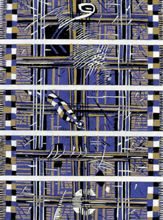 Haky Jasim Haky Jasim
Göteborg, Sweden
Sonatina II
Woodcut
50 x 37cm
1996
Collection of the artist
‘The work of innovation is an everlasting search for beauty. Technically, I attempt to make my graphic work as close as possible to painting through the treatment of the surface, the illusion of relief and the intensity of colour. For me, colour is an independent topic or issue. I employ artistic oriental elements in a way similar to Sufi rituals that turn the abstract to illusion - a Sufi reality. I do not merely accept the symmetrical element that is the focus of the oriental - Sufi. I create a colourful rhythm with geometrical structures, which may seem tranquil. Nevertheless, it is a dynamic rhythm moved by the harmony of colours found inside the complex composition. Creative style is above all a personal identity that is endless.’ Haky Jasim . 1999
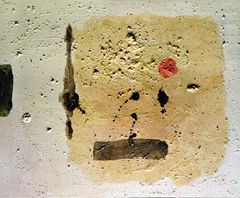 Jafar Kaki Jafar Kaki
Madrid, Spain
Petra Brown
Mixed media on canvas
60 x 73cm
1999
Collection of the artist
'Personally, I regard poetry and music as some of the core elements in the continuous making of the artist’s disposition and the essence of his/her vision in general. I am therefore constantly aware and informed of all that is occurring in the world of art, cinema, theatre, music etc, with the intention of artistically fusing their perpetual presence with our surroundings, time and place. The human also being plays a pivotal role in my perception of life. My artwork, both in painting and etching, depicts my viewpoints from an interior and exterior perspective. In order to maintain the purity of expression, my art is spontaneous, interacting directly with the canvas or zinc. Spanish critics perceive my work as free abstract expressionism.’ Jafar Kaki . 1998
‘The artistic expression of Jafar Kaki is characterised by a language of great intimacy, like a secret inside the abstraction. The singular poetic vision in the working process gives evidence of the creative originality in his paintings.’ José Marín-Medina1 . 1998
‘The birth of the image: a tension which resolves itself in the dialogue, between the interior of the artist and the exterior of the support, is obvious in all works of Kaki. He paints, draws and engraves with tense feelings in response to impulses which force him to reach out for the paper or the canvas. It is there that he portays not only what he sees in his imagination, but also what he wants to see: the equilibrium or disequilibrium of light, colour and of non figurative forms, these he utiilizes to tanslate his feelings as a person and as an artist. In his paintings, he uses a mixture of techniques as a vehicle to an expressive intensity.’ Adolfo Castaño2 . 1997
1 Conmemorativa de los Certamenes Caja, City Museum, Madrid, 1998
2 Jafar T Kaki, ABC Cultural, No. 309, 3 October, 1997
 Leila Kawash Leila Kawash
Virginia, USA
Hexahedron
Mixed media on wood in Perspex
42 x 42 x 42cm
1997
Collection of the artist
Transcending Time
‘As an Iraqi artist with an American mother and Iraqi father, brought up in Baghdad, conflicts and contrasts started early in my life. The complexities of these varying cultures have enriched my perspective and certainly affected my artwork. One of the main underlying themes in my work has been about complexities. I begin my work with lines or textures. I use lines as boundaries and proceed to defy them, painting over the lines or fading them into the distance, thus conflicts arise between the rigidities of the lines and the fluidity of the paint. While sifting through sand an archaeologist discovers part of an ancient ruin that conjures far greater images than the shards of glass or pieces of pottery that are in his hands. Ghosts of the past dance before him. Using many layers of paint, fragments of collage, heavy textures and light washes, I have tried to piece together different time periods, to find a place where the past and present overlap, where countries shed their boundaries and distances. The artwork is simply the merging point of these things and of the experiences of my multi-cultural perspective, beyond the linear lines of time, beyond the straight gashes of any boundaries. My pieces make sense out of the fragments, the many dimensions of womanhood, of ethnicity, of travel: like the archaeologist who is essentially the assembler of what is ruined or missing, the unifier of the broken or lost pieces of self. In my use of three-dimensional cubes, I have drawn from Islamic influences, calligraphy and geometric shapes, challenging them with loose, flowing washes of colour. The cubes stand alone or are enclosed in a Plexiglas cube. In these works I attempt to tug at the boundaries and broaden the vision, deepen the dimension, creating something that one can actually walk around, has an inside and an out, and can be seen in a variety of views. I am always freshly exhilarated when I reach into the riches of our past that make me proud to have come from that ancient part of the world Mesopotamia. I carry these treasures deep within. The ancient currents of the Tigris and Euphrates flow through my veins and weave themselves in between the colours and textures. While the Goddess Innana whispers her legacy to me from a distant place.’ Leila Kawash . 1999
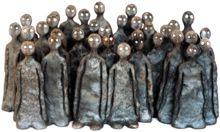 Nihajet Khalaf Nihajet Khalaf
Amsterdam, The Netherlands
Al-Muta’abidoun (The Worshipers)
Ceramics, raku
35 units 15/20 x 10cm
2000
Collection of the artist
‘My art practice is a kind of worship in pursuit of spiritual continuation; between the chaos of life and the mysteries of the soul, between mortality, disaffection and alienation of the heart, between discovery and escape. It is the impossible balance.’ Nihajet Kalaf . 2000
 Amer Khalil Amer Khalil
Baghdad, Iraq
Tragedy
Bronze
31 x 8 x 8cm
1998
Private collection
‘Amer Khalil’s work is profoundly affected by his origins, a small village near the Euphrates. Drawing on the readily available raw materials of his native region, he usually works in wood, transforming tree and palm trunks into painfully stretched human faces. Their surreal expressions are born out of both the natural growth of the local wood and the artist’s experience of his people, their faces carved by their harsh existence and daily struggles: each individual part of what he calls ‘‘Human Jungle’’. Here, he has translated his large-scale work in wood into an intimate version executed in bronze, thus inviting the viewer to contemplate the human agonies, the silent screams and the fatalistic resignation locked up in a human face at close range.’ Ulrike al-Khamis . 2000
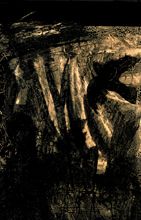 Osama Khatlan Osama Khatlan
New York, USA
Bird in the Night
Photopaint
58 x 40cm
1998
Collection of the artist
‘Khatlan, who has spoken of his reliance on feeling as the primary inspiration for his prints, has created a work whose eloquence is based on the jagged, expressionist use of colours. It is a profoundly metropolitan outcry, and its pathos suggests that the artist’s New York life as a foreign born artist has not lacked distress. Osama Khatlan’s art strikes the viewer as profoundly urban and implicitly international in its suavity. He is a man interested in the portrayal of both the physical movement and the random, yet acute, music of life in the city. In that sense, his fluent renderings of emotion look both to the human and to the abstract. The results are quite moving.’ Jonathan Goodman[1] . 1996
[1] The Shadow of the Eye, Islington Museum Gallery, March 1997, London
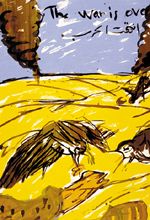 Salam Khedher Salam Khedher
Bulach, Switzerland
Intehet al-Harb (The War has Ended)
Silkscreen print
72 x 57cm
1992
Collection of the artist
‘What entices me in our culture is its humanitarian aspect. As values of eternal reality, in its future and past adherence, I attempt to bring intellect and spirituality to an intuitive level through my art. Yet, a complete and positive expression, which can mystify and motivate, does not emerge purely through visual insight but also through contemplation and thought. Creative ability and the development of technical skill have empowered the maturity of my artwork in a co-ordinated intellectual aesthetic saturated with the spirit of a youthful personality. Since we exist in a conditional culture, we cannot escape from viewing art in set frames of time and circumstance. And yet, human imagination need know no borders. As human beings we are uniquely enabled to communicate our concentrated dreams and fantastic concepts.’ Salam Khedher . 1999
 Hana Mal Allah Hana Mal Allah
Baghdad, Iraq
Codes and Signs
Mixed media on canvas
77 x 77cm
1998
Private Collection
‘If my symbols continue to have the same meaning, I remain static. Therefore, I am always on the lookout, I am always evolving my experiences.’ Hana Mal Allah . 1999
‘Hana Mal Allah’s paintings are complex symbols of her imagination, sparked by her concern about the impact of technology and humanity on her reality and her environment, particularly city life. She has sensitised herself to registering the most complex array of visual, aural and sensual impressions when walking through her city. These she consciously digests, keenly aware of the mutating impact of her personal thoughts, emotional reactions and perceptions. Mal Allah’s main struggle is to translate her inner visualisations on to canvas, doing justice to the mentally and emotionally taxing complexities she experiences in the process. The resulting works codify her living environment with all its fleeting moments, impulses and impressions into an iconic plane of intricate, labyrinth-like structure, powerful colour, elevations and cryptic symbols that defy intellectual decodification. To complicate matters further Mal Allah is committed to imbue her chosen codes and symbols with different meanings each time, as to her repetitiveness would weaken their meaningfulness.’ Ulrike al-Khamis . 2000
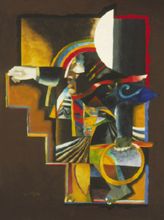 Ali Mandalawi Ali Mandalawi
London, England
Witness . 1992
Private Collection
‘Inspired by the poetry of Abdul Wahab al-Bayati, ‘Title of artwork’ was part of an exhibition entitled 'Feather from the Wings of a Cloud’ which I held in Amman, Jordan, in 1992. With that presentation, I attempted to illustrate the change of direction that my artistic expression was going through at the time. The work marked my 'inaugural' liberation from prevalent technical and stylised forms, which had up to that point signified my artistic output. I say 'inaugural', because it marked my realisation that art should be entirely free to become in itself a space where the artist can roam and linger, a space also for aesthetic and educational interchange between the artist and his work on the one hand and the viewer on the other. In this artwork I place a touch of initiating freedom. A sensation pulsated within me, with a whisper from here, sparks from there, remnants of cloud and confusion, anxiety and interactions. The hand, moulded for placing delicate brush strokes over small white spaces, in its new found freedom feels compelled to move from the small, innocent game of colouring expanses of paper to scratching, tearing or even burning and spreading the ashes. Hence, this artwork symbolises a dance of freedom within the atmosphere of a poem!’ Ali Mandalawi . 2000
 Fakhir Mohammed Fakhir Mohammed
Baghdad, Iraq
Untitled
Oil on canvas
89 x 89cm
1998
Private collection
‘It would only be unfair not to consider the influences of the visual consciousness of my work, on the surface construct, in general, as my most recent work has been developing with a special intrinsic visual rhythm of its own. This has generated its own creative consequences far from any conceptual constraints or logical shaping. The works have assumed their own visual equations and relationships for an autonomous development...living in their own temporal space...finding units of positive and negative expanse...equations for movement: point, line, geometrical shape, square, triangle, or even texture...using areas of light colour equal to others of stronger colour. In all, this serves the purpose of increasing the impact of the surfaces with autonomy. This creates an Islamic atmosphere reminiscent of mosques' walls and doors, cemeteries’ entrances...so that the visual construct creates a certain entry into other parallel architectural constructs like a seed that dies in order to produce its potential.
In my work, it is quite important to let the visual units originate their own relationships with each other as well as with time and space. In spite of my strong tendency towards an experimental attitude to prove the technique learnt in academia, I think that by granting a life to the surface, the surface can capture the realistic experience and its essence by thus expressing it.
At a certain stage the works start to have their own logical sequence or almost creating each other like an act of reproduction held throughout by a thread, or a secret dialogue, aesthetically self-sufficient...hence remaining faithful to their own unity, independence and totality of visual construct.’ Fakhir Mohammed . 1998 . Translated by Saadeh George
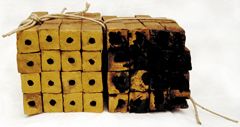 Nedim Muhsin Nedim Muhsin
Amsterdam, The Netherlands
Baghdad A-B
Ceramics; stoneware
Two of 20 x 20 x 20cm
1996
Collection of the artist
‘Nedim Muhsin studied under Rafa al-Nasiri. In his early days he pursued his studies with a hunger for knowledge of the essential core of teachings and visions of contemporary art. He studied them intensely and was to remain deeply conscious of the essence of groundbreaking artists like Kandinsky at a fundamental level. Illuminated by their gist yet highly individual and original. However, given this basis it was not long before Muhsin embarked on pursuing an aritstic vision liberated from all traditional boundaries and conventions. His path since has been one of experimentation and searching; a path that sees art as a primary adventure. Every idea is transformed in a spontaneous, incidental way, translated with a spirit of immediacy, yet considerable skill. A trademark of his approach is his commitment to pattern and the creation of interconnections between the individual visual elements. With time, Muhsin began to work actively on deconstructing all he had acquired during his artistic education and academic training. As a result he long stayed clear from any of the artistic configurations so conspicuous in contemporary Iraqi art. One exception to that rule was his involvement with Studio 4 in Amman during 1993. It was then that Nedim’s commitment to new horizons in his art really took off. Rather than composing an artwork he set out to ‘‘decompose’’, to create, as he calls it, ‘‘non-art’’. Familiar art materials are deformed or violated in the process and the visual end result is one that repels and intriguingly attracts at the same time. Nedim Muhsin sets out to confront his audience with their inability to comprehend his work readily and classify it. His aim is to rekindle a child-like sensation of curious investigation, a re-sensitisation of human imagination and intellectual interaction.’ Ulrike al-Khamis . 2000
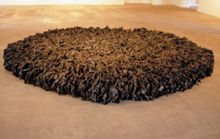 Maha Mustafa Maha Mustafa
Malmö, Sweden
Untitled
Paper and light installation
250cm diam
1998
Collection of the artist
‘Maha seems partly to have solved or to be on the verge of solving the conflict between her own tradition and the western tradition in her sculptures. She is seeking a sort of primitive form, as did Brancusi, rooted in his Romanian peasant tradition, or from another point of view certain surrealists in what they called ‘‘objects with a symbolic function’’. Her pillar-like sculptures make you think of tribal art, and she tells me that she has found inspiration in conceptions from prehistoric times in Mesopotamia. Some ornamental details recall Babylonian cuneiform script, the origin of all written languages. Later she worked with simple geometrical forms which, placed in opposition to one another, produce elementary contrasts: escape-rest, silence-music, life-death. These contrasts, which paradoxically are also correspondences in the simplest possible way, she creates by making for example casts of branches that make you think of bones (do the branches look like bones or the bones look like branches?) or pillows on which an invisible head seems to rest. Looking at her mysteriously tempting boxes I realise that I can say nothing, except possibly in the form of a poem. She places a vegetable on a table and lets time pursue its black magic. The vegetable becomes shrivelled, hardens, corresponds no longer to its name. When something is alienated from nature in this way, it comes closer to man. It can be a pumpkin, a pepper, a bitter orange, which gradually blackens and slowly turns into a final negative of itself, a small concentrate of sorrow and abandonment. Not even the Babylonian gods will eat this remnant. Maybe it frightens the observer into reverence. Because of that she puts the object carefully on the softest of beds in a wooden box with a lid. There it rests as if in a bird’s nest. But she does not lock the lid. Relics are there to remind us that holy things are perishable as well.’ Lasse Soderberg1 .
1995
1 About the Magic of Maha, Barbacka Art Museum, Sweden, 1998
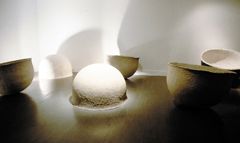 Mahmud al-Obaidi Mahmud al-Obaidi
Ontario, Canada
Dome Project
Mixed media
3 units 150 x 160cm each
1999
Collection of the artist
‘For two decades, I have been looking forward to accomplishing a work related to the soul and its sublimation. Today more than ever before, I find myself attached to this vast universe. I find myself full of desire to ascend farther and farther vertically, to the highest point possible so that I can see the Earth’s configurations as small as dots, just tiny dots in the infinite universe. In order to record such a vision, I have to take a simple approach to forms and items, as the elements of the earthly scene become more complex and its colours more intertwined. Figures relinquish their undulations, and colours converge, proclaiming their association with distinction. Thus clay becomes the main key to form and colour. Endowed with Eastern cultural roots, I develop such kinds of vision against a background of Eastern philosophy that abounds with fascinating flashes concerning the meaning of creation and creativity. God alone is the creator, the inventor. Man is a mere imitator. Thus I opine that the coloured planes and forms applied by the artist on his panel are simply obtuse imitations of nature’s genius. Why do we not simply cut the route short and try to portray nature in its formations and colours the way it is? Creation is ‘‘making’’, namely creating without reference to a previous example; it is production in the absolute sense of the word, whether using an already existing matter or without it. To quote the Arab philosopher Ibin Rushd; ‘‘A term exists; it was made from another thing, through the work of a creator and preceded by time. This is the case of the matter, whose substance we perceive through the senses. In the final analysis, it is a relationship between the Creator and the world. It is a relationship between one and the many, between the Constant and the variable, the immaterial and the material’’.’ Mahmud al-Obaidi . 1999
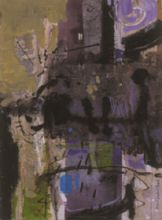 Mohammed Quraish Mohammed Quraish
Amersfoort, Netherlands
Windows
Mixed media
12 units 15 x 15cm each
1999
Collection of the artist
‘Form, colour, area and content combined with traces and memories of innate shapes and symbols, ancient and new, in search of new horizons. Because art is a life value, I confront it logically and cautiously with innocence far from chaos. With colour, I return to the non-conscious, towards a childhood, in an attempt to recapture my freedom, occasionally within a world intermingled with imagination and remembrances of visions in alliance with the mind. This emerges as openings or windows in a vast space, creating for those who desire another performance for the reality of matter.’ Mohammed Quraish . 2000
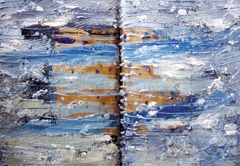 Ibrahim Rashid Ibrahim Rashid
Malmö, Sweden
Earth Book
Mixed media on wood
30 x 40 x 4cm
1998
Collection of the artist
‘Ibrahim Rashid’s artistic vision makes him one of the creative artists, not only as a painter but as a researcher who can develop through interaction with his culture, life and the international art movement.’ Shakir Hassan Al Said[1] . 1994
‘Expressive, spontaneous and frank, Ibrahim Rashid’s paintings have gone through a rapid yet consistent development. From the socially committed figurations influenced by Picasso that he painted in his youth, he has by way of a violent, brilliantly coloured expressionism arrived at the abstract painting to which he devotes himself today. He works impulsively, but not without awareness. He treats his means of expression with masterful confidence converting every painting into a homage paid to unconditional creation in itself and consequently - on a political level if you wish - to external freedom. A direct symbol for this unconditional creation is water, which he has celebrated in a long sequence of acrylic paintings on photographs: water, the unhindered flowing element, the deluge washing clean and sweeping away, the fertile rain, the four rivers of Paradise. Ibrahim also writes about art. He shows me an article on modern Iraqi painting in relation to Western modernism. For me, such a theme immediately poses a question. ‘‘What do the descendants of ancient Babylonia, where gods or at least some of them took earthy shape, where the first city civilisation came into existence and where the first work of literature Gilgamesh was created, have to learn from murderous, godless Europe?’’ Maybe I can find, if not an answer, then at least a seed to the answer in Ibrahim’s work.’ Lasse Söderberg[2] . 1998 . [1] Contemporary Art and Ibrahim Rashid, Al-Talea’a al-Adabbia, Baghdad, 1 Feb 1990[2] The Stone of Recollection, Barbacka Art Museum, Sweden, 1998
 Rebwar Rebwar
London, England
Colour And Word
CD installation and painting
Acrylic on paper
4 units 29 x 21cm each
1999
Collection of the artist
‘In my country, when a woman grieves, you can read her sorrow only from her face - the colours of her dress will shine strongly and defiantly.’
‘During the past two years I have been engaged in a project entitled ‘‘colour and word’’ where I have sent out over seven hundred of my original paintings to poets and writers all over the world. So far, I have received over three hundred responses. The idea of the project was to ask the poets to write a text or poem on their emotions and first reactions when they received my paintings, each of which deals with a theme, inspired by my Kurdish background. By now poems and texts from the most diverse cultural backgrounds have been received. They were written in Farsi, Arabic, Greek, Chinese, English, Welsh, Spanish, Hebrew, Kurdish, Italian, German, Swedish, Indian, Russian, Dutch and Polish.’ This undertaking has provided the seed to a global, potentially eternal artwork that brings together like-minded artists and intellectuals all over the world in a creation that transcends all ethnic, religious, cultural and political boundaries. They are united by a higher ulterior motif and that is art. Rebwar . 2000
‘To meet Rebwar is to meet with peace, with humour and with humility; and yet his life has been and is a potent mixture of love, of beauty and of tragedy beyond most of what we, in the West, have experienced collectively in the past forty years. His paintings and prints are a historical narrative of his experience. He illustrates the bittersweet relationship of life and death, of love and hate. He illustrates in sadness and in celebration, but not with condemnation, for he is as concerned for the perpetrators of the terrible genocide inflicted upon his people in 1988 as he is for his own family and close friends. As an artist and writer Rebwar tolerates our western concerns for art practice. However, he retains his own unequivocal position as a Kurd whose destiny is to illustrate in pictures and in prose the story of the Kurdish nation - the lack of understanding and the persecution to which it is constantly subjected. It is his essentially human position which comes through his work.’ Professor Martin Pitts1 . 1998
1 Pitshanger Manor Gallery Exhibition Catalogue, London, Jan/Feb/March 1998
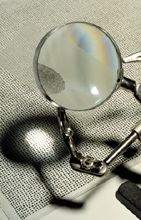 Talal Refit Talal Refit
Bad Bentheim, Germany
Identity
Mixed media installation
3 units 40 x 30 x 40cm
1998
Collection of the artist
'Art
The very situation
The aggregate condition
The essential solution
The impossible colour
Where knowledge and latency
Melt together
God’s image is his absence
The Elements
‘Lens: focus on ‘‘fingerprint’’ above rainbow reflection of the pattern lying underneath.
Balance: a balance between seven-pointed wax star; ‘‘the crystal form of energy’’ against a date stone: ‘‘the embryo’’.
Like the other components, I usually try to reduce the idea in a fragile nucleus form to enable individual communication between the element and the viewer. The delicate combination of the elements portrays the very immediacy of the situation. Using the physical forces of ‘‘balance and optics’’ lends the image a universal involvement, like a magical space. This helps the elements to interact, producing thought and retaining the authenticity of the idea.
Since childhood, ‘‘drawing’’ has been my indispensable companion. As a child, I grew up alone, which is not typical for an Iraqi family. At seventeen I left Iraq. So ‘‘art’’ throughout my childhood compensated for brothers and sisters, and later, my home country. Hence, I owe my art to patience and optimism. Art’s warmth and universality compels me to embrace it. For me, it was and continues to be an absolutely vital practice to feel the purity of existence.’ Talal Refit . 1999
 Resmi Resmi
Prato, Italy
Desire To Live
Oil on Canvas
150 x 90cm
1998
Collection of the artist
‘My drawings capture a moment in time, be it an actual life experience or a passive one. This in turn is related to the conditions endured by many Iraqis today, issues such as displacement and its impact on our emotion. During my life away from my birthplace, my artistic accomplishment can be summed up in two basic stages. The first is where I tackle the subject ‘‘Freedom of Dream’’, founded on the basis that ‘‘dream’’ is the only mechanism for living instances, which are not really possible. By this, I mean moments related to my childhood, youth and memory, in comparison with the intense impression of living in Diaspora. The second stage is an investigation of the ‘‘tree of life’’; a subject as broad as life itself. This period was a transferral from a dark era drenched in endless nostalgia, to one luminous with life, in an attempt to connect memory with the present in a metaphysical style, a spiritual extension. In Freedom of Dream, an analogy exists between the embracing trees and birds and the agitated human roots of a woman and a man. At times, it is positive human endeavour and at others, it is the selfishness in our being. My ‘‘desire to survive’’ carries the inner truth of all human creations represented in the enduring relationship between a man and a woman; survival and continuation. The ‘‘tree’’ is a symbol used to elevate this reality, protecting it from all that is evil. Those viewing the figures in my artwork find them somehow distanced from earth. With this I attempt to express the purification of human love, maintaining its authenticity and abstracting it from the residues which it accumulates on earth. ‘‘Light’’ is an affirmation of this thought in that it originates from within to illuminate our surrounding environment.’ Resmi . 1999
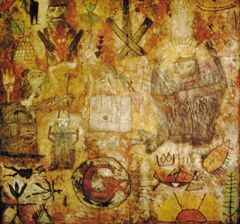 Kerim Rissin Kerim Rissin
Baghdad, Iraq
Untitled
Mixed media on wood
93 x 67cm
1992
Private Collection
‘Kerim Rissin’s work is profoundly rooted in the artistic and literary legacy of ancient Mesopotamia. The complex imagery encountered on tablets and cylinder seals, the enigmatic cuneiform characters of old, fantastic mythological beings and creatures from the Epic of Gilgamesh: all are echoed in the cryptic and child-like compositions that characterise Rissin’s pieces. Magic talismans and tattoos derived from the folkloristic traditions of his native Iraq further enhance his visual language. Yet, Rissin’s message is a contemporary one: the human concerns and struggles that mark his reality and that of his immediate environment are codified in a symbolic and enigmatic language. Only few may fathom its meaning in full, but to all it offers signs and traces of daily human existence and life through its nervous energy and antagonistic themes. In that the artist perpetuates the same method of communication his ancestors in ancient Mesopotamia utilised: for initiated onlookers from other cultures or another age the messages conveyed remain partly obscured, yet strangely compelling and awe-inspiring. For those ‘‘within’’ on the other hand every detail as well as the artwork as a whole has a distinct meaning and a definite message.’ Ulrike al-Khamis . 1999
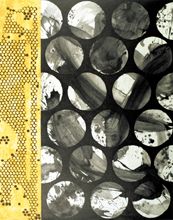 Munir al-Saadawi Munir al-Saadawi
Madrid, Spain
Untitled
Etching, aquatint
100 x 76cm
1998
Collection of the artist
‘My work is informed and inspired by the hourly and daily events of our human existence in relation to our surroundings. First and foremost, it is launched from a philosophical understanding, presented in abstract form. It explores humanitarian issues; the tragedies, struggles that we face and our fight for survival. My artworks are not only documentary realities, but rather plans for occasions that require subconscious meditation distancing us from the state of non-concern and irresponsibility: art as an element for thought and mutiny. I do not write about myself. I paint about myself. I appreciate architecture in an open landscape and construct my artwork in much the same way as an architect, connecting with that of the Bauhaus, in all its intellectual and artistic school of thought. However, I use further stimuli coming from music, classical or contemporary. I need a rhythm of alternation; the peaceful surroundings of my home and the big cities with all their hustle and bustle. It reassures me to know that I have plenty of time at my disposal. I live in and with my work. I paint in opposition to all things usual. There are no perfect solutions. The same is not the same. Man is at the centre of my expression. Like nature, he/she lives within contrasts, tensions and disturbances. In the existential sense we are at the mercy of controlled disorder, or uncontrolled order. My artwork is an attempt to translate this complex, unfathomable enigma into artistic reality. Art must not offer finished solutions or systems; the continuing work remains exposed.’ Munir al-Saadawi . 1999
 Rashad Selim Rashad Selim
North Africa, Europe and England
Figure at the Edge of Hope
Wood sculpture
85 x 24cm
1998
Private collection
Nurtured by two cultures, Eastern and Western, I find a transient third in the geometry of travel and the fruits and experience of the journey. The potentials pulled as enigmatic traces from the ash of an Eden consumed haunt me; love in the chaos of a promise betrayed. My main work is in printmaking, an art form that I feel opens onto all the visual arts. I explore, through innovative techniques, found objects that inspire a meditative process generating images that are many layered visually and conceptually. Using Intaglio, stencil, viscosity, block and offset printing (sometimes simultaneously) I discover geology in the shards of an old gourd, a lost civilisation in the architecture of egg cartons, lyrics in the rigid grid of a wire mesh, the language of water in the warping of its plastic container. In a recent series I transformed the diskettes encased inside computer floppy disks into aerodynamic objects that dance to the play of elementary physics. In another series I took the Arabic letter Ain on a journey through the alphabets of the world and found a commonality of shape with sound despite topography and language. I have been in a near constant state of travel and adjustment to new surroundings of well rooted realities and I find in the small raft of my creativity with its accumulation of impressions both the passport and the gift to cross the void with…’ Figure at the Edge of Hope is one in a series of sculptures made during the last year of my stay in Sanaa, Yemen, 1997. Some carved in wood, others formed with a mixture of materials on an armature of woven steel. As with most of my works, a wide range of influences inspired their creation. The functional Kadhadh[1] reliefs with strange anamorphic shapes that decorate and protect traditional houses. The mono-chrome graphic images found on late Abbassid ceramics and the figurative style of engraved Mesopotamian cylinder seals all echo in these sculptures. Rashad Selim . 2000
[1] Special waterproof plaster
 Kamal Sultan Kamal Sultan
Tarragona, Spain
Window
Mixed media on paper
55 x 80cm
1986
Collection of the artist
‘For me, art remains a means for dialogue, communication and constant inquisition in which the artist is continually challenging himself, and at the same time allowing the viewer the freedom to contemplate.’ Kamal Sultan . 1998
‘In his artworks, Sultan is not in search of what is ‘‘visual’’ or ‘‘photographic’’, but for that which represents the link between ‘‘intentional’’ versus ‘‘incidental’’ and ‘‘enigmatic’’ contra our ‘‘humanitarian existence’’. His artwork on paper, canvas or wood is in a state of shifting individuality, carrying the imprints of this harmonious exchange between what is humanitarian and environmental as well as what is personal and thematic. Consequently, in what means or capacity does Sultan attempt to confront the world, only too aware of the mutual rules, which exist between human beings and their environment? A world of texture, colour and unconventional surfaces define his artwork. Without doubt, his work reflects an intermediate state, which requires transforming artistic vision from its ‘‘visual’’ to ‘‘non-visual’’ state and where a simple line or spot of colour permeates the subject matter. Alas, we have the right to question ‘‘does Sultan not attempt to heed to the call of the ‘other’ instead of projecting his own voice’’? The answer lies within his art.’ Shakir Hassan Al Said[1] . 1992
[1] Solo Exhibition Catalogue, Cambrils Municipality, 1996
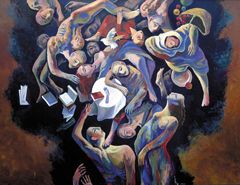 Sadiq Toma Sadiq Toma
London, England
Hurricane
Acrylic on canvas
138 x 178cm
1996
Collection of the artist
‘There are broken hearts, not anger. My lines are curvaceous and my colours are positive. I am an optimist by nature, and this is conveyed in my artwork. Many of the figures are of couples bowed into one another, curled like the petals of a flower, ready to bloom and encounter the world afresh. There are times that you and your partner can only react by turning to each other, taking comfort from each other and indeed excluding the world around you. Nevertheless, there will always come a time when you open to that world together.
I work within a mixture of expressionism and realism where I tend to produce work that communicates to those who look for the symbols and the meanings of the constructions that are underneath the obvious image. Although my paintings are personal, they are also relevant to others. To produce stimulating art does not necessarily mean experience. But if you have experienced war, and you have seen the killing, then your work will reflect that and be poignant. If you have not experienced war, your art will never reflect the truth of the emotion. ‘‘Love’’, as well as ‘‘loss’’ cannot be expressed by a paintbrush, but by the heart of the artist. In my work, I believe that I show that I am an experienced optimist.
I do not make statements about the reasons behind my leaving home. The mere fact that I am here, is itself a statement. Faces and bodies, are waiting, are yearning, are bestowed upon with light. I paint expressions in the lines of the figures more than the faces. Rather than looking at the lines of the faces, by observing the movement of the body, you can sense the emotions on a deeper level. There are wounds and cuts. There are bruises. ‘‘Departure’’ is a time of sadness. An unwilling departure from one’s homeland is a time of great sadness. One never really knows when it will be possible to return. Until such time, I shall keep on painting, I shall carry on communicating.’ Sadiq Toma . 1998
|
